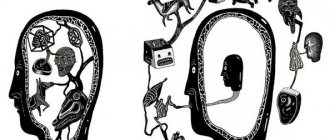- A little about the history and methodology of the Cattell test
- Forms of Cattell's test
- Cattell test - passing rules
- Cattell Test - Form A, 187 questions
- Decoding the Cattell test: primary factors
- Additions to deciphering the results: secondary factors
- Additions to decoding results: combinations of primary factors
Cattell's 16-factor personality questionnaire (or 16 PF ) is one of the most famous psychological tests in the world. In particular, many applicants encounter it during interviews (including in government and law enforcement agencies). The Cattell questionnaire is also used in other areas, and given the detailed characteristics that the subject receives as a result of passing the test, it is of great interest from the point of view of self-diagnosis. If you want to take a look at yourself from the outside, learn something new about yourself, or simply satisfy your curiosity about what lies behind the designation “16 PF questionnaire,” we invite you to take the Cattell test online (and, of course, completely free). However, first we turn to the questionnaire itself, its features and various forms.
16-factor questionnaire: essays on the history and methodology of R. B. Cattell
Those who, before passing the Cattell multifactorial questionnaire, would like to know more about the test itself and its features will find the relevant information under the spoiler.
Cattell test: general information
Raymond Bernard Cattell is an adherent of differential psychology, the author of over 50 books on psychology and several theories that have had a significant impact on the development of psychological science and practice. At the same time, he is known to many as the creator of the 16-factor personality questionnaire. To be fair, we note that, of course, Cattell did not develop this test alone, but it was he who led the corresponding scientific group. Experts note that Cattell is the first psychologist who paid such close attention to factor analysis as a method of psychological diagnostics. As a result of research, R.B. Cattell identified 16 independent factors that most fully describe personality. Actually, this quantity formed the basis of this test. Of course, factor studies existed before the Cattell questionnaire, but the 16 PF was the first to combine so many characteristics in one test
.
Interestingly, other psychologists subsequently said that the 16-factor questionnaire was too detailed and that a smaller number of factors would be enough to fully characterize a personality. But, in our opinion, the popularity of this test for more than half a century and its widespread use eloquently indicate that even if the results of the questionnaire can be considered too detailed, this not only does not stop numerous users, but also additionally attracts them. In general, the questions on the Cattell 16-Factor Test are designed to cover a large number of different personality traits
.
Moreover, during the test, subjects will have to both describe their attitude to a particular phenomenon or talk about their typical behavior, and solve small logic problems. [collapse]
Forms of Cattell's test
At the moment, several forms of the Cattell multifactorial questionnaire have been developed. Their diversity is associated not only with subsequent adaptations and modifications of the “original” options, but also with the fact that different lists of questions were required for subjects of different ages and with different levels of education.
The first forms of the Cattell test - A and B, consisting of 187 questions,
- were published in 1949-1950.
A little later, forms C and D appeared, containing 105 questions each
.
All these options are designed for adult respondents with secondary or higher education. In the early 1960s, Forms E and F were released, with 128 questions
.
A little later, versions of this multifactor questionnaire appeared for minor subjects - for children (12-factor test)
and
adolescents (14-factor)
.
In addition, there is a short version of the test for adults - the 13-factor test
(accordingly, its short name is 13 PF). It contains 79 questions.
Currently, the most common forms among adults of the Cattell 16-Factor Inventory are Form A (which you will find below) and Form C (you can try it on this page). In addition, we present a teenage version of this test.
Answer form
| a | b | c | a | b | c | a | b | c | a | b | c | a | b | c | a | b | c | a | b | c |
| 1 | 18 | 35 | 52 | 69 | 86 | 103 | ||||||||||||||
| 2 | 19 | 36 | 53 | 70 | 87 | 104 | ||||||||||||||
| 3 | 20 | 37 | 54 | 71 | 88 | 105 | ||||||||||||||
| 4 | 21 | 38 | 55 | 72 | 89 | |||||||||||||||
| 5 | 22 | 39 | 56 | 73 | 90 | |||||||||||||||
| 6 | 23 | 40 | 57 | 74 | 91 | |||||||||||||||
| 7 | 24 | 41 | 58 | 75 | 92 | |||||||||||||||
| 8 | 25 | 42 | 59 | 76 | 93 | |||||||||||||||
| 9 | 26 | 43 | 60 | 77 | 94 | |||||||||||||||
| 10 | 27 | 44 | 61 | 78 | 95 | |||||||||||||||
| 11 | 28 | 45 | 62 | 79 | 96 | |||||||||||||||
| 12 | 29 | 46 | 63 | 80 | 97 | |||||||||||||||
| 13 | 30 | 47 | 64 | 81 | 98 | |||||||||||||||
| 14 | 31 | 48 | 65 | 82 | 99 | |||||||||||||||
| 15 | 32 | 49 | 66 | 83 | 100 | |||||||||||||||
| 16 | 33 | 50 | 67 | 84 | 101 | |||||||||||||||
| 17 | 34 | 51 | 68 | 85 | 102 |
Cattell test - passing rules
So, we invite you to take Form A of the Cattell 16-Factor Personality Inventory
.
It was adapted into Russian by A.G. Shmelevs and others. As we already mentioned, it contains 187 questions
(plus 2 questions relating to your gender and age). When answering them, it is recommended to adhere to the following principles:
- answer quickly
without thinking about the answers; - as with all psychological tests, there are no right or wrong answers
, and to ensure the result is as accurate as possible, give the most sincere answers; - try to give “average” options as little as possible
(“Not sure”, “Sometimes”, “I don’t know”, etc.). Even if you don't like the other two answers, try to choose the one that is still closer than the other.
As with some other similar tests, scoring a completed question paper gives what is called a raw score.
walls
using special formulas . It is in accordance with the latter that the results in the transcript are compared. Note that when conducting the Cattell test live, with a psychologist, as a rule, a personality profile is also compiled.
A transcript of the Cattell test results will be given after passing the test, and will also be reproduced below under spoilers. These are 16 primary factors, 4 secondary ones, as well as explanations for the combination of primary factors: from them a number of conclusions about personality can also be drawn. Please do not reload the page while taking the test, receiving the results and reading the transcript!
Otherwise, the results will be reset and the test will have to be taken again.
Key
The coincidence of the subject’s answers with the “key” is assessed as two points for answers “a” and “c”, the coincidence of the answer “b” is scored as one point. The sum of points for each selected group of questions results in the value of the factor. The exception is factor “B” - here any match of the answer with the “key” gives 1 point.
| Factors | Statement numbers | ||||||
| M.D. | 1 ab | 18 bc | 35 bc | 52 bc | 69 bc | 86 bc | 103bc |
| A | 2 bc | 19 a.b. | 36 bc | 53 ab | 70 ab | 87bc | |
| B | 3 b | 20 s | 37b | 54 s | 71 a | 88 s | 104a 105b |
| C | 4ab | 21 ab | 38 bc | 55 ab | 72 bc | 89bc | |
| E | 5 bc | 22 bc | 39 bc | 56 ab | 73 bc | 90 ab | |
| F | 6ab | 23 ab | 40 bc | 57 ab | 74 ab | 91 bc | |
| G | 7ab | 24 bc | 41 ab | 58 bc | 75 ab | 92 bc | |
| H | 8ab | 25 bc | 42 bc | 59 ab | 76 ab | 93 bc | |
| I | 9 ab | 26 ab | 43 bc | 60 ab | 77 bc | 94 bc | |
| L | 10 ab | 27 bc | 44 bc | 61 bc | 78 ab | 95 ab | |
| M | 11 bc | 28 bc | 45 ab | 62 ab | 79 ab | 96 bc | |
| N | 12 bc | 29 ab | 46 ab | 63 ab | 80 bc | 97 bc | |
| O | 13 bc | 30 ab | 47 bc | 64 ab | 81bc | 98 ab | |
| Q1 | 14 ab | 31 ab | 48 bc | 65 bc | 82 bc | 99 ab | |
| Q2 | 15 ab | 32 bc | 49 ab | 66 ab | 83 bc | 100 bc | |
| Q3 | 16 ab | 33 ab | 50 ab | 67 bc | 84 bc | 101bc | |
| Q4 | 17 a.b. | 34 bc | 51 bc | 68 ab | 85 bc | 102 ab | |
Decoding the Cattell test: primary factors
The areas of greatest interest in personality profiling are low and high (i.e., peak) scores. High scores mean scores of 8 and above
, under low –
from 0 to 3
. Average scores, as a rule, show a balance between two opposing characteristics (with a bias towards the corresponding pole, if such a bias exists). Factors and explanations for them are given under spoilers.
Scale A: withdrawn – sociable
High score holders
open, sociable, happy to make contact: they easily get to know people, interact successfully in small groups, love to work in a team.
Among their advantages are that they are easy to communicate with, natural, and help resolve conflicts. Among the shortcomings are that they are overly trusting and easily adapt to other people - to the extent that they can follow their lead. Low scores
are typical for those who prefer to work independently, are uncommunicative, and are constrained in making acquaintances and maintaining social contacts.
Such people are often called cold and distant. Among their characteristics are that they are distrustful, strict, critical, but they are prone to accuracy. [collapse]
Scale B: intelligence
Despite the name of the scale, intelligence, as understood in IQ, has nothing to do with it. High scores
characteristic of those who have developed abstract thinking and who think quickly.
Such people learn easily and, as they say, grasp everything on the fly. Low scores
indicate that a person has less developed abstract thinking and verbal culture.
He needs more time to think (search for solutions to various problems) than the holder of high scores. [collapse]
Scale C: emotional instability - stability
People with high scores
emotionally stable, calm, self-possessed, even imperturbable.
These are mature individuals, with stable interests and a sober, rational, objective view of things. There is little that can piss them off, to the point that they are characterized by some insensitivity. Holders of low scores
, in turn, are emotionally unstable: they are easily irritated, react strongly even to insignificant things or phenomena - a lot of things unsettle them.
As a rule, such people are characterized by mood swings and often change interests. They can run away from problems and conflicts and get tired quickly. [collapse]
Scale E: subordination - dominance
High scores
talk about a dominant personality.
Such a person tends to think independently, without relying on public or anyone else’s opinion. These individuals are assertive, stubborn (even to the point of displaying aggression), they are not accustomed to recognizing the authority of others. Because of their behavior, they can enter into conflicts and behave like rebels. Low scores
are given to those who are characterized by conformity.
From a social point of view, such people have a lot of positive qualities: they are soft, tactful, kind, easy to make concessions, modest and obedient. On the other hand, they are quite easy to control, they can take on someone else’s guilt, and are often passive and dependent. [collapse]
Scale F: restraint - expressiveness
High scores
characteristic of people who are not used to restraining their feelings and emotions.
They express vividly how they feel in the moment, including how they treat others—especially if it is a good attitude. They are impulsive, expressive, energetic, cheerful, usually cheerful and active. But at the same time they are careless, inattentive and careless. Those with low scores
, on the contrary, are overly cautious and prudent, even to the point of being closed.
Such people speak little and do not like to show emotions, but they are thoughtful, reasonable, and obliging. While individuals with high scores are carefree, those with low scores are pessimistic and often worry about what might happen in the future. [collapse]
Scale G: low – high normative behavior
High scores
According to this factor, they are characterized by obligatory, responsible, disciplined people who try to fulfill their promises and adhere to social norms and rules.
Such individuals conscientiously fulfill their duties, persistently pursue their goals - as they say, you can rely on them. Low scores
indicate that a person does not always keep his promises and does not perceive social norms as binding.
Such people are not always responsible and conscientious; “I want” is more important to them than “I should.” In principle, they have a sense of duty, but under the influence of other momentary feelings (including laziness or the desire to relax), it can fade far into the background. [collapse]
Scale H: timidity - courage
For those who received high scores
, characterized by courage, determination, enterprise, and activity in achieving goals.
Such people take risks (sometimes unjustified), make extraordinary decisions if there is a chance that they will help cope with the problem (meanwhile, note that those with high scores do not always accurately calculate the consequences of their actions). The same courage extends to social contacts: they are not shy about communicating with strangers. Those who score low
are, on the contrary, timid, cautious, cautious people who do not like to take risks and experience stress when interacting with strangers.
They are shy and prefer to remain silent in company. But they react very sensitively to any dangers and threats. [collapse]
Scale I: cruelty - sensitivity
High scores
characteristic of sensitive and, one might even say, sensual people.
They are impressionable, artistic, emotional (and the range of their emotions is very wide), they love creativity and create themselves. They have a well-developed imagination and a sense of beauty. They empathize and sympathize well. Among the negative traits, such people are considered dreamers, cutesy, overly romantic, soft and, as a result, weak. In turn, the cruelty of those with low scores
should not be taken literally.
This is not cruelty as such, but much less sensitivity, rigidity, lack of empathy, weak empathy and sympathy. Such people are direct, rational, trust only logic and reasoning, and not intuition. Among their negative traits is that they may seem callous, stingy with emotions and not understanding art and aesthetics. [collapse]
Scale L: gullibility – suspicion
High scores
they say that their owner treats others, if not suspiciously, then at least warily.
Such people are self-centered, do not admit their mistakes and demand that others follow their norms and rules. As a rule, they have high self-esteem, they are jealous and irritable. Individuals with low scores
, on the contrary, are trusting, open, easily obey authorities, do not have high ambitions, and most importantly, do not experience envy and jealousy.
These are good-natured, patient people who often make concessions. [collapse]
Scale M: practicality - daydreaming
Those who received high scores
, can often hear that they are dreamers and have their head in the clouds.
These are creative people with a well-developed imagination, often passionate about art: they either work in one of these professions themselves, or simply love art. They do not always obey social norms and are often self-absorbed in their ideas. Those with low scores
are figuratively said to be “down-to-earth people.”
They are rational, focused on specifics, real (not abstract) tasks. These are reliable and conscientious people who, however, can appear narrow-minded due to their focus on everything practical. Such individuals are accustomed to focusing their behavior on generally accepted principles and morals. [collapse]
Scale N: straightforwardness - diplomacy
High score holders
, as the name of the scale suggests, they are diplomatic, they know how to behave in society and how to find a common language with different types of interlocutors.
Such people are usually insightful, resourceful in communication, can be cunning, and even make their counterparts wary. They also know how to analyze a situation and control the actions of the group. Low scores
are typical for straightforward people: such people do not dodge, but prefer to say what they think.
They are very frank, but at the same time spontaneous, naive, sometimes lacking tact, have a poor sense of other people’s motives, and are harsh and direct in their communications. People often say about such people that they are “simple.” [collapse]
Scale O: calm - anxiety
High scores
show that their person worries about everything and worries about everything.
Such a person is suspicious, feels guilty, has low self-esteem, is depressed (even to the point of depression), and vulnerable. Hypochondriacs often receive such scores. In addition, people with high scores on this scale are quite pessimistic: they often listen to their intuition, which does not give them positive predictions. Despite the name of the scale, those with low scores
tend not so much to be calm as to be carefree and self-confident.
They are confident in their abilities, energetic, active and cold-blooded. They are usually cheerful and do not pay attention to the approval and disapproval of others. [collapse]
Scale Q1: conservatism – radicalism
High scores
characteristic of those who like to experiment, look for new ways and solutions and are ready to put up with inconveniences and overcome difficulties for this purpose.
These are freedom-loving people, often with analytical thinking, who do not always follow established rules, do not do something just because it is customary, and are accustomed to testing everything in practice. Those with low scores
are, accordingly, conservative, suspicious of innovations, and prefer to follow traditions and foundations (if not public ones, then their own).
Such people, on the contrary, are ready to endure difficulties and inconveniences in order not to change anything. They often tend to moralize, lecture, and lecture others. New people are also treated with suspicion. [collapse]
Scale Q2: conformism - nonconformism
High scorers
differ in that they are guided by their own opinions, and not the opinions of others;
can act alone, and not with an eye on the group. These people are self-sufficient, independent, have their own point of view on various issues, and strive for leadership in their group. Low scores
are typical for those who are more dependent on their group, need its approval, act with an eye on others, may not have their own opinion, but take the opinion of the group.
Often such people like to be in society and do not like to take initiative and make decisions on their own. [collapse]
Scale Q3: high – low self-control
High scores
they say that their owner is a person with a developed will, purposeful, and completes the work he starts.
Such a person controls not only himself, his behavior, but also those around him, because, as a rule, he is quite powerful. Low scores
are typical for people with weak willpower, who cannot or do not want to resist desires and emotions and simply follow their mood (usually often changing).
Such individuals are undisciplined, may not complete things or may not show proper persistence, and are not always attentive to others. [collapse]
Scale Q4: relaxation - tension
High scores
characteristic of those who are distinguished by concentration, activity, energy, and a high level of motivation.
But sometimes such people show irritability, aggression and excessive nervousness - this can be the result of accumulated excess energy and tension. Low scores
indicate that their owner is not very collected, sometimes lethargic, and does not mind being lazy.
Such people usually remain calm, bordering on indifference and apathy. [collapse]
Additions to the Cattell Test - Secondary Factors
In fact, Cattell's 16-Factor Personality Inventory is about more than 16 factors.
.
In addition to the primary factors (of which there are actually 16), the test also gives results for 4 secondary ones . In the test they are designated as F1, F2, F3 and F4
. Let us recall that high (8-10) or low (0-3) scores speak most clearly about a personality, and average values indicate the middle between the poles with a predominance of one or another pole.
F1 – anxiety
High scores
talk about a high level of anxiety, and this can be either anxiety caused by the specific situation in which the test subject is at the moment (it may not be related to the test, but, as they say, can’t get out of your head), or a general high level anxiety (the J. Taylor Personality Anxiety Scale test will tell you a little more about this factor).
In addition, high scores may signal internal discomfort associated with the fact that a person would like to change something in his life, but cannot or does not dare. Low, but close to average (3-5) scores
indicate not only a low level of anxiety, but also that, most likely, a person feels enough confidence and strength to achieve his goals.
Too low scores (0-1)
may indicate decreased motivation.
[collapse]
F2 – extroversion/introversion
High scores
are characteristic of extroverts (they easily make contact, like to make acquaintances, are sociable),
low scores
are typical of introverts (they may experience difficulties in interpersonal communication, they are not so easy to make contact).
[collapse]
F3 – sensitivity
High score holders
Most people make decisions quickly, not always caring about the consequences or fully studying the issue.
Their sensitivity (that is, the emotional response to various events, words, actions and other “irritants”) is not at the highest level. As for those with low scores
, their sensitivity is usually high, and this brings them closer to melancholic people.
When making any decisions, such individuals, for the most part, prefer to think carefully about actions before starting to implement them, comprehensively analyze the problem, predict negative consequences and protect themselves as much as possible from them. [collapse]
F4 – conformity
This trait speaks of dependence on the group - subordination to its rules and instructions, initiative, whether the individual needs support and approval from the group/society, etc. Those with high scores
As a rule, they prefer to follow their own rules, not always paying attention to the opinions of others.
Often, high scores mean that a person is capable and likes to take initiative. Low scorers
often think differently: they need support and submit to the demands of social groups.
This behavior is easier for them, as it allows them not to make their own decisions and not stand out from the crowd. [collapse]
Conversion table from raw scores to standard scores (walls)
| Factors | Walls | |||||||||
| 1 | 2 | 3 | 4 | 5 | 6 | 7 | 8 | 9 | 10 | |
| Low | Average | High | ||||||||
| A | 0-4 | 5 | 6 | 7 | 8 | — | 9 | 10 | 11 | 12 |
| B | 0-2 | — | 3 | — | 4 | — | 5 | 6 | — | 7-8 |
| C | 0-3 | 4 | 5 | 6 | 7 | 8 | 9 | 10 | 11 | 12 |
| E | 0-1 | 2 | 3 | 4 | 5 | 6 | 7 | 8 | 9 | 10-12 |
| F | 0-1 | — | 3 | 4 | 5 | 6 | 7 | 8 | 9 | 10-12 |
| G | 0-3 | 4 | 5 | 6 | 7 | 8 | 9 | 10 | 11 | 12 |
| H | 0-3 | 4 | 5 | 6 | 7 | 8 | 9 | 10 | 11 | 12 |
| I | 0-3 | 4 | 5 | 6 | 7 | 8 | 9 | 10 | 11 | 12 |
| L | 0-1 | 2 | — | 3 | 4 | — | 5 | 6 | 7 | 8-12 |
| M | 0-3 | — | 4 | 5 | 6 | 7 | 8 | 9 | 10 | 11-12 |
| N | 0-1 | 2 | 3 | 4 | 5 | 6 | 7 | 8 | 9 | 10-12 |
| O | 0-1 | 2 | 3 | 4 | 5 | 6 | 7 | 8 | 9 | 10-12 |
| Q1 | 0-4 | 5 | 6 | — | 7 | 8 | 9 | 10 | 11 | 12 |
| Q2 | 0-2 | 3 | — | 4 | 5 | 6 | 7 | 8 | 9 | 10-12 |
| Q3 | 0-2 | 3 | 4 | 5 | 6 | 7 | 8 | 9 | 10 | 11-12 |
| Q4 | 0-1 | 2 | 3 | 4 | 5 | 6-7 | 8 | 9 | 10 | 11-12 |
| M.D. | 0-2 | 3 | 4 | 5 | 6 | 7 | 8 | 9 | 10 | 11-12 |
- Building a personality profile.
When interpreting, attention is paid primarily to the “peaks” of the profile, i.e., the lowest and highest values of factors in the profile, especially those indicators that in the “negative” pole are within the boundaries of 1 to 3 walls, and in the “positive” pole » - from 8 to 10 walls.
- Interpretation of results.
The walls are distributed on a bipolar scale with extreme values of 1 and 10 points. Accordingly, the first half of the scale (from 1 to 5.5) is assigned the “–” sign, and the second half (from 5.5 to 10) the “+” sign. From the available indicators for all 16 factors, the so-called “personality profile” is built.
Combinations of primary factors according to the Cattell test
Of interest in deciphering the 16 PF questionnaire are not only the descriptions of the 16 primary factors themselves, but also their combinations. So, all factors can be divided into four blocks:
- block of communicative properties (factors A, H, E, L, N, Q2);
- block of intellectual properties (factors B, M, N, Q1);
- block of emotional properties (factors C, F, H, I, O, Q4);
- block of regulatory properties (G, Q3).
Let's look at some interesting combinations within these blocks. Let us remind you that by high scores we mean 8-10 walls
, under low –
0-3
. Average results usually indicate a balance between two opposing characteristics.
Communication properties block
A and H – communication style (need, initiation)
High scores
Based on both factors, they say that this is a very sociable person.
He easily makes connections and maintains contacts. As a rule, he has many acquaintances, but most of the relationships are superficial, which, however, does not care or upset such a person. For the owner of this result, there will be no problem speaking in front of a large audience (and even winning their interest). Low scores
indicate that when it comes to the number of friends, their owner most likely adheres to the principle “Better less is more.”
Such a person may have very few friends, but the ones he has are truly close to him. He is unlikely to initiate contacts of his own free will, and speaking in front of an audience is a great stress for him. [collapse]
L and N – understanding of other people
High scores
both factors indicate that such a person well understands the thoughts, feelings, motives (including hidden ones) of other people and is able to change his attitude towards certain persons depending on changing circumstances.
At the same time, the consequence of constant (albeit, perhaps, unconscious analysis of others) may be some tension in relationships, detachment, mistrust, and labeling. Those with low scores
do not always understand what others really mean by their words or actions, and sometimes this becomes the cause of disappointment or resentment.
At the same time, without wasting resources on searching for subtexts, such people are more sincere in their communication and change their attitude towards a person only under the influence of emergency circumstances (for example, due to betrayal). [collapse]
E and Q2 – leadership issues
High scores
indicate high leadership potential - such a person is inclined to subordinate and/or persuade, rather than obey and/or accept other people's points of view.
Has his own opinion on many issues and will defend it until victory; used to doing things his own way, even if they didn’t agree with him. Low scores
, accordingly, indicate low leadership potential - such a person prefers not to develop his own opinion, but to agree with someone else’s (including the new point of view of the team, if it has suddenly changed);
does not like to make decisions if they concern him alone, much less a group of people. It is easier for a person of this type not to lead, but to follow the leader. [collapse]
Smart properties block
B and M – intellectual orientation
High score holders
They are more focused on abstract thinking, they have well-developed fantasy and imagination, they easily find logical relationships between phenomena, thanks to which they usually cope with various abstract tasks without problems.
Those with low scores
are more focused on solving practical issues.
They actively use knowledge and facts, establishing mainly cause-and-effect relationships. [collapse]
N and Q1 – flexibility of thinking, speed of decision making
high scores demonstrate the highest flexibility and speed in decision making
.
In addition, as a rule, such people are not afraid of experiments and creative, innovative approaches, and as a result, the failures that may follow these approaches. Those with low scores
often spend more time searching for a solution, take longer to delve into a situation, and have a negative or wary attitude towards innovations and/or unusual ways of doing things.
[collapse]
Emotional properties block
C and I – sensitivity, reaction to emotional influence
High scores on factor C and low scores on factor I
they say that their owner gives preference to reason over feelings: he is prone to rationalization, realism, and not to the perception of reality through feelings and emotions.
When deciding something, such a person is guided by logical arguments. Accordingly, for those who demonstrate the opposite results - low scores on factor C and high scores on factor I
- emotions come to the fore.
They perceive the world based on their feelings. At the same time, such individuals have a wide range of emotions, and strong emotions - both positive and negative - can be caused by even an insignificant event or phenomenon. [collapse]
H and F – attitude towards failure and risks
Failures come along everyone's path. As a rule, people who showed high scores
Due to these factors, troubles and defeats do not lead you astray.
Such individuals are optimistic and believe that everything will be fine, even if at that particular moment they have failed. A certain disadvantage of this approach is an easy attitude to risk - the ability to bet almost anything without thinking about the consequences. Those who have low scores
are wary of risk and avoid such situations at all costs.
In addition, such people are quite pessimistic, tend to ask “What if...” questions or overcomplicate things. Therefore, they prefer not to take risks or not do something at all, just to avoid failure. [collapse]
O and Q4 – anxiety
High scores
indicate a high level of anxiety, not only about the present or future, but also about the past.
People of this type can worry for a long time about what should have been done/said in a given situation. As a rule, they rate their strengths and capabilities quite low, and even a small problem or failure can make them give up. In turn, those with low scores
can go ahead: they believe in themselves and that they will succeed.
Sometimes such people are overly self-confident and tend to look for problems not in themselves, but in others. One way or another, for the most part they successfully cope with the obstacles encountered along the way. [collapse]
Block of regulatory properties
G and Q3 – ability for self-motivation and self-organization
High score holders
As a rule, they do not experience problems with self-motivation, including if they fail on the way to their goal.
You can rely on such people - they take their responsibilities and what they do for others responsibly (even if it is not about work, but about a friendly request). Such individuals, for the most part, plan their time (including long-term plans - career, life, etc.) and prefer to bring the things they start to their logical conclusion. A low result
means that its owner is most likely accustomed to retreating when a significant (or sometimes even not very significant) obstacle comes his way.
Such people usually do not like to plan time and are not always able to sensibly assess their strength. In addition, they do not look far ahead, focusing more on today. [collapse]
F3. Sensitivity
Low scores indicate a tendency to have difficulty being emotional in everything. These people may be the dissatisfied and frustrated type. However, there is a sensitivity to the nuances of life. Probably there are artistic inclinations and softness. If such a person has a problem, then resolving it requires a lot of thought before taking action. High scores indicate an enterprising, determined and flexible personality. This person tends not to notice the nuances of life, directing his behavior towards what is too obvious and obvious. If difficulties arise, they cause quick action without sufficient thought.









